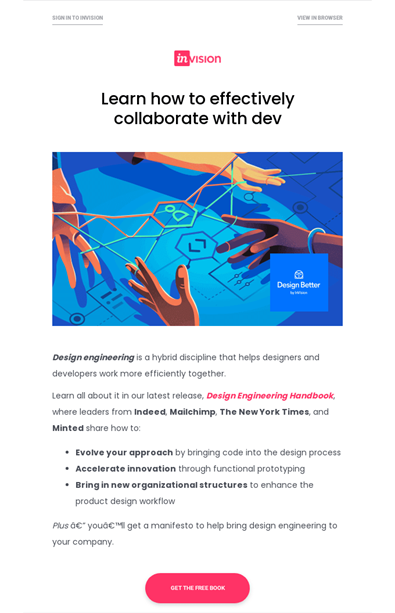It’s Not Your CTA — It’s the Journey to It
If you have been following my posts here on the Only Influencers blog, you'll know that I'm just as fascinated by the psychology behind email marketing as I am about the mechanics. Maybe even more so!
That's because I want to understand why our customers do what they do with our emails and our businesses, and how we can tune our emails to tie in with that.
Why psychology matters
Successful email marketers don't get that way because they use the latest technology, the most beautiful designs, or the snappiest copy. It's because they understand how the choices they make in their emails help or hinder a customer's decisions, starting from the initial opt-in.
One of the best books an email marketer can read has nothing on the surface to do with email marketing. It's the ground-breaking Thinking, Fast and Slow published in 2011 by Nobel Prize winner Daniel Kahneman.
In it, he introduces the concepts of "System 1" and "System 2" thinking:
System 1 = Fast thinking. It's your lizard brain: rapid, subconscious, automatic, emotional, and intuitive. Makes decisions fast but is prone to error through impulse and bias. It guides most of our decision-making.
System 2 = Slow thinking. It's logical, deliberate, and analytical. It can see potential problems and override System 1, but it needs time.
You can see how the interplay of these two systems of thinking can affect a customer's decisions on everything to do with your email, from opening to clicking, and even beyond it to the landing page, to affect the decision to convert.
In my years of work with email, I've learned we're often trying too hard to appeal to one system of learning when we should be reaching out to the other.
Consider the click rate
Let's start with a basic email metric, the click rate. If it's low, the call to action often gets the blame.
Ask Google or your favorite AI chatbot, "How do I fix low email click rate?" You'll get a rush of tactical answers, like "Keep it simple." Or "Put it high in the email." Or "Put it lower in the email." Or "Never use a red CTA button color." Or "Try a red CTA button color."
So you play around with button copy, color, and placement. You switch out the button for a text link (ouch.) You test the change. And still, nothing works.
Are you the problem, or is it your customers? Yes.
By this, I mean it's probably not one single feature in your email that's keeping people from clicking. What comes before the customer clicks is what matters.
When you understand how that journey affects the customer's decision in the moment to click or not to click, you can use this knowledge to create emails that accommodate these psychological factors and manage them to make clicking more desirable.
How trust, logic, and emotion play into the click decision
People don’t read emails. They're in System 1, scanning for signals that answer subconscious questions like these:
- Do I trust this brand?
- Is this relevant to me?
- Am I motivated or emotionally engaged?
If your email doesn’t earn that trust and clarity before the CTA, no button can save it. It also doesn't matter how much information you provide, however logically you present it.
In "The Buyer's Mind," a course I developed for the Holistic Email Academy, we explore how buying decisions rarely begin in the logical, deliberate System 2 brain.
Instead, they begin in System 1, which asks, "Is this safe? Is this interesting? Do I trust this? WIIFM?” If the brain doesn't get the answers it needs, it tunes out, long before it ever hands off the decision to System 2.
Here's where the problem begins. Because we as marketers are most likely operating in System 2 when we create our messages, we carry that into our emails.
- We appeal to logic, not emotion.
- We list features instead of telling a story that gives customers a reason to believe and connect.
- We use corporate language instead of the words that mean more to our customers.
Then we throw in a CTA button, fuss over the wording, and assume that will do the job. Your reader might see it, but if it lacks emotional connection, they scroll right past it.
Maybe that's why I keep seeing statistics that say email engagement is holding steady, but clicks are down!
What to fix before you blame the button
If your CTA isn’t converting, don’t just test the copy. Instead, ask:
- Did I build trust first? Use a human tone, imagery, social proof, and clear and helpful copy, written in language your customers understand, to show you’re credible and safe.
- Did I make the relevance obvious? Lead with why: What's in it for them, not what you want them to do.
- Did I appeal to System 1 first? Use curiosity. Appeal to emotion. Add compelling but related visuals. Appeal to the intuitive brain first.
- Did I add friction before the ask? Jargon, long intros, or generic benefits can slow the brain down.
Review low-performing campaigns for these problems
The call to action is just one element to re-examine. It's the tip of the iceberg. What’s underneath — the clarity, trust, and emotional pull — gives the CTA its power.
If people aren’t clicking, don’t just polish the button. Rebuild the path that leads to it.
- Check the framing.
- Build trust earlier.
- Nudge with relevance and psychology — then ask for the click.
When you test, focus on the customer's mindset before the click. Does the CTA fit in with the email's trust-building, clarity, emotion, relevance, and timing? That's when the magic happens.
Getting it wrong and right
1. When the email goes wrong: Here's a nice-looking email that follows best practices of good design and content – attention-getting image, lots of white space, crisply written copy -- that leads the eye to the CTA. But it has a big problem.

What went wrong: It forces the brain into System 2 too soon. Customers aren't ready for the deep analysis and brainwork this B2B email requires. The message doesn't use elements that resonate in System 1, such as the "what's in it for me" question, nor does it appeal to the emotion a person would experience when design and development don't work well together.
Instead, the email plunges into the rationale for buying, brings in big names to talk about the product, and assumes readers already understand the value.
2. When the email goes right: The email below shows how to package content appealing to System 1 and System 2 thinking in a scannable, attractive message.

- System 1: The copy taps into the emotional factor jeans-wearers often experience by assuring them, “The perfect jean does exist.”
- System 2: In a few paragraphs of carefully chosen copy and images, the email explains why Selvedge denim is different.
This is masterful content creation because it shows how you can appeal to two key systems of thinking and create email beauty, all at the same time. In an age when people can buy cheap jeans on the street corner, content like this can persuade logical System 2 to assure impulsive System 1 that it's safe to click on the email.
Want to put this psychology into practice in your own email strategy?
Sign up to the Holistic Email Academy today and get immediate access to our Intermediate: Strategic Email Marketing - From Vision to Value course — valued at £75, it's yours free when you join.
You'll also be the first to hear when the Academy officially launches, giving you the opportunity to sign up for The Buyer’s Mind — our deep-dive course into how real decisions are made and how to use that insight to drive more meaningful results from your emails.
 Photo by Dino Reichmuth on Unsplash
Photo by Dino Reichmuth on Unsplash

 How to resolve AdBlock issue?
How to resolve AdBlock issue? 